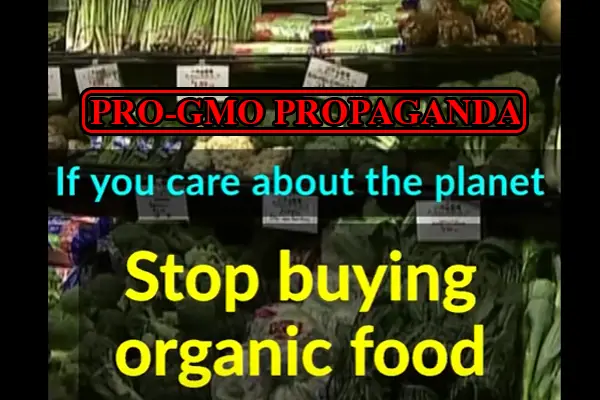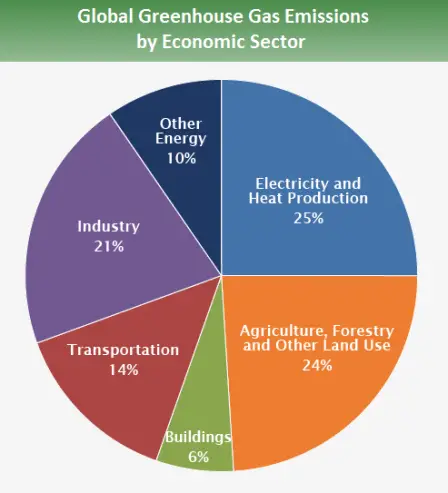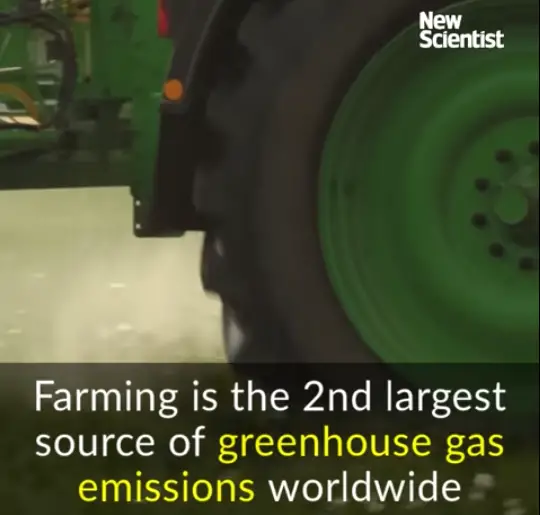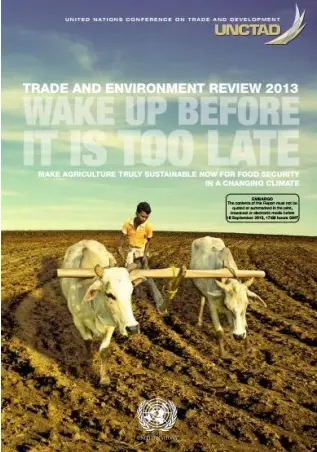
A recent video watched over 4 million times tells viewers to stop buying organic food. But its claims are questionable.
Popular international magazine New Scientist found itself in the midst of an intense controversy (of the social media variety, that is) after publishing an article titled ‘Stop buying organic food if really want to save the planet,’ along with a video that was viewed more millions of times on Facebook.
Viewers were caught off guard by the video’s defiant and authoritative tone — and many of them fired back in the comments section, defending organic food from what they saw as an unwarranted and misguided attack.
At a time when organic food has become exceedingly popular, and supporters of organic agriculture truly believe they’re making a positive difference, the video, barely over a minute long and devoid of sources (except for the link to a short companion article in the comments section and accessible only by creating an account with the website), came as a shock to many.
So, do the claims of New Scientist really hold water? Or are supporters of organic food being unfairly demonized?
Let’s examine further. But first, check out the video below to see what all the fuss is about:
Video Claim #1: “Farming is the 2nd Largest Source of Greenhouse Gas Emissions Worldwide” and “Organic Food Results On Average in Higher Greenhouse Gas Emissions Than Conventional Farming”

Source: Intergovernmental Panel on Climate Change (2014)
The second source of global greenhouse gas emissions (after electricity and heat production) falls under the category of agriculture, forestry, and other land use (a total of 24% of all emissions).
This is a large group combining different sources of gas emissions together that needs to be broken down into segments in order to fully understand its complexity.
Animal Farming and Climate Change
The biggest source is enteric fermentation, accounting for 40% of total emissions in this category. It is a process of emitting methane gas produced in digestive systems of ruminants, grazing animals such as cattle, sheep, and goats. Enteric fermentation also takes place in non-ruminant animals but to a lesser extent.
The data shows that large-scale animal agriculture in general, is greatly responsible for greenhouse gas emissions. A total of 18% of greenhouse emissions (more than transportation) is because of animal agriculture, which makes switching to a more plant-based diet one of the best things you can to help curb these emissions.
After animal farming, other sources of greenhouse gas emissions are manure left on pasture (16%), synthetic fertilizers (13%), rice cultivation (10%), and manure management (7%).
Unfortunately, the video doesn’t address what’s actually causing these emissions, misleading people into thinking growers of organic crops are solely to blame — despite the fact that organic agriculture offers plenty of solutions that aren’t being utilized.
Fertilizers: How Organic Can Flip the Script
Manure is used primarily on organic crops, and perhaps one of the biggest issues organic farming can still improve upon (large amounts of it could be eliminated if animal agriculture was reduced and people ate less animal products). There are other organic fertilizers that can be used, however, such as a combination of different mixtures of plant compost, rotation crops such as legumes, and mineral treatments to nourish the soil, among many others.

A screen from the New Scientist video.
Besides organic fertilizers, organic agriculture also is far more likely to utilize crop rotation, a system of planting crops in a specific order, which feeds the needed nutrients into each next crop and lessens the need for synthetic fertilizers.
A recent study by Stanford researchers found that planting legumes as part of a crop rotation can act as a natural fertilizer, reducing the need for synthetic fertilizers that cause emissions as well as environmentally devastating algal blooms and oxygen-depleted “dead zones” through farm runoff.
It’s yet another example of the untapped potential of an organic farming approach.
While organic farming is often seen as a monolithic system, there are plenty of other branches that are capable of tackling problems, using other symbiotic techniques including crop rotations.
One such system is biodynamics, a holistic technique that follows the natural rhythms of the planet and creates a balanced ecosystem for the crops to get the nutrients they need naturally.
Permaculture is another system of integrating all parts of the environment to work together, allowing crops to flourish without the need for synthetic fertilizers. The system has been used most effectively in Cuba since the 1990s and created a food revolution for the country, a dynamic growing system that flows in a natural rhythm similar to how food grows in the wild.
Another proposed solution is regenerative agriculture, which utilizes grazing animals in traditional ways while growing food. While it does leave manure on pasture, supporters say that this type of agriculture can help sequester carbon in the soil and bring carbon net emissions back into balanced and safe levels.
Unfortunately for supporters of organic food, the true abilities of these systems are not being adequately studied or supported. Most top agricultural universities are fully on board the GMO and agrochemical train because of how profitable it is, due to multi-million dollar corporate donations (learn more here). And most media sources (like New Scientist, for example) are too busy promoting and defending these industries to even notice the potential of organic.
As for government funding of conventional vs. organic, it’s not even close to a fair fight: according to the National Sustainable Agriculture Coalition, the amount of research being allocated to organic and holistic farming techniques is still merely “a tiny fraction of the over $2.8 billion annual federal investment in food and agriculture research.”
Perhaps it’s time to move in a different direction?
Organic Versus Conventional Crops: The Rice Revolution
The next large category of farming emissions is rice cultivation. And in some studies, organic rice has been shown to produce more gases than conventional rice, but it strongly depends on how that rice is grown.
In India, one family proved that we do not need GMO rice or synthetic chemicals to grow a large harvest. Sumar Kumar and his family grew an incredible 22.4 tons of rice from one hectare of land in 2013, sparking a rice revolution in India.
Instead of planting old rice seeds in clumps, the family used System of Root Intensification (SRI), which can also be used on wheat, potatoes, sugar cane, yams, and many other crops. Using this system requires only half the seeds usually needed, and maximizes yields per acre. It works by nurturing the seeds, then transplanting them as seedlings into the field one-by-one with enough space in between allowing roots to get air. The system works on the premise that “less is more.”
“Farmers use less seeds, less water and less chemicals but they get more without having to invest more. This is revolutionary,” said Dr. Surendra Chaurassa from Bihar’s agriculture ministry.

Indian farmer Sumant Kumar grew 22.4 tons of rice on one hectare of land. Organic farmers in developing countries have produced extremely high yields according to a University of Michigan study (Photo via The Guardian).
Whether using SRI system or other methods, a study from Spain has shown that for many other crops besides rice, many other crops emit fewer gases when grown organically, such as cereals, legumes, open-air and greenhouse gardening.
“…We observed a general trend for lower greenhouse gases emissions under organic management,” the study concludes.
“…Organic farming has been shown to effectively mitigate climate change by increasing carbon sequestration in the soil, reducing greenhouse gas release and consuming less fossil fuel,” according to the Organic Farming Research Foundation
Organic agriculture has a lot of tools to grow the harvest even more with less input on less land: biodynamics, regenerative farming, permaculture, SRI and many other systems are capable of leading the way to the future. As a whole, organic has been shown to be better not only for human health but also better for the environment.
And as you’ll see shortly, farmers in developing countries are producing more on less land despite having far less resources than the monoculture, corporate-driven agriculture you’ll find in the United States.
Let’s look at other claims New Scientist brings up.
Video Claim #2: “Because Yields are Lower, Organic Farms Require More Land”
While that may be true for some farms, we do see how organic farmers, such as the aforementioned Kumar in India, can overcome that obstacles with ingenuity, experience, and knowledge of their land and tools.
Urban farming is yet another untapped system that has great promise, even in harsh conditions.
Will Allen, a former professional basketball player based out of the projects of Milwaukee, has been spotlighted in several outlets including the The New York Times. Allen works out of the Growing Power center, where he grows enough food to feed an estimated 10,000 locals; Allen famously claimed he grew a million pounds on three acres.
While the exact numbers have been disputed, Allen has clearly demonstrated the power of growing food indoors using a thriving, closed-loop ecosystem that incorporates aquaponics, complementary plant and animal life, and much more.

Will Allen is recognized as one of the top urban farmers in the United States.
Studies Show HUGE Productivity From Organic Farms in Developing Nations
While it is true that there are studies showing greater yields per acre for conventional farms, others actually show far more potential for organic crops, particularly in places where food security is low.
One study from the Research Institute for Organic Agriculture in Switzerland showed that organic farms were 20 percent less productive than conventional over a 21-year period.
However others show a much smaller gap, or improved yields from organics. Bill Liebhardt, an agricultural scientist from the University of California-Davis, found that U.S. organic corn yields were 94 percent of conventional yields, wheat was 97 percent, and soybean 94 percent. Organic tomatoes showed no yield difference.
Still other studies have shown results that most people would never believe possible from organic farmers. But they oftentimes don’t get the same type of attention because of the perception that organic farming is unsophisticated or archaic.
Many farmers in the developing world are shattering yield records, as noted in this article:
“University of Essex researchers Jules Pretty and Rachel Hine looked at over 200 agricultural projects in the developing world that converted to organic and ecological approaches, and found that for all the projects-involving 9 million farms on nearly 30 million hectares-yields increased an average of 93 percent…”
More evidence from India also shows the potential of organic farming: a seven-year study from Maikaal District in central India showed yields as much as 20 percent higher for several organic crops.
And an international study from University of Michigan researchers found that organic farming yielded less in developed nations, but actually yielded more in developing ones. In both cases they produced more than enough to feed the world.
“We were all surprised by what we found,” said Catherine Badgley, one of the Michigan study’s lead researchers and a paleoecologist. The study was based on a local farmer’s experience growing an incredible 27 tons of vegetables on just six-tenths of a hectare during a short growing season in the Great Lakes State. It inspired the team to look for as many comparisons between organic and non-organic yields as possible, and 293 were uncovered in total.
The team ran two models applying the yield ratios of conventional farms in the developed world, and yield ratios of organic farms in the developing world, to the entire planet. Even when the more conservative organic yield model (from the developed world) was applied to the rest of the world, it still produced significantly more food than is necessary per person per day.
Applying the second model showed a huge benefit to going organic:
The first model yielded 2,641 kilocalories (“calories”) per person per day, just under the world’s current production of 2,786 calories but significantly higher than the average caloric requirement for a healthy person of between 2,200 and 2,500. The second model yielded 4,381 calories per person per day, 75 percent greater than current availability — and a quantity that could theoretically sustain a much larger human population than is currently supported on the world’s farmland.
Badgley said that concerns about clearing wild areas, such as the tropical forest shown in the New Scientist video, to produce food are mostly unfounded (those areas are mostly cleared to make way for cattle farms and GE soy to feed them).
A holistic, organic approach, if done right, combines the beauty of a diverse natural world with the production of the world’s top farms. Studies routinely shower greater biodiversity for organic farms.

Even the UN says that small scale natural farming is the way to feed the world and protect the environment. Click the picture for more info.
“If we simply try to maintain biodiversity in islands around the world, we will lose most of it,” Badgley said. “It’s very important to make areas between those islands friendly to biodiversity. The idea of those areas being pesticide-drenched fields is just going to be a disaster for biodiversity, especially in the tropics. The world would be able to sustain high levels of biodiversity much better if we could change agriculture on a large scale.”
Small Scale Natural Farming Can Feed the World and Respond to Climate Change
In 2013, the United Nations said that small-scale organic farming is the best way to “feed the world” and protect the environment in its report ‘Wake Up Before It’s Too Late.’ The report specifically mentioned biodynamic farming as an untapped resource.
“What is called for is a better understanding of the multi-functionality of agriculture, its pivotal importance for pro-poor rural development and the significant role it can play in dealing with resource scarcities and in mitigating and adapting to climate change,” the report said. “Questionably, priority in international policy discussions remains heavily focused on increasing industrial agricultural production, mostly under the slogan “growing more food at less cost to the environment.”
Overall, the message was clear: we don’t need giant monoculture farms to assure that we produce enough food to feed the world, or to protect the environment. We need to change the system from the ground up.
Video Claim #3: “The Most Promising Technology for Reducing Farming Emissions is Genetic Modification”
The New Scientist video says that “The Most Promising Technology for Reducing Farming Emissions is Genetic Modification,” adding that “GM Crops Are Being Developed to Capture More of the Sun’s Energy and Require Less Fertilizer.”
But the video’s only source is the aforementioned short article that is only readable after registering for the site, and that article’s source for its claims on GMOs is a November 4 article titled ‘Trials Planned for GM Superwheat That Boosts Harvests By 20%.’
The article mentions a new genetically engineered “superwheat” that is said to increase the effects of photosynthesis, having the potential to “boost yields by 15 to 20 percent.” But it still hasn’t even been approved for field trials in the UK, a country where no GM crops are commercially grown.
One of the “superwheat” crop’s researchers, Malcolm Hawkesford, admitted that new strains would have to be developed in the future and it’s anyone’s guess as to whether they will perform the same in the field — the crops are “a long way off,” as the New Scientist article’s author Michael La Page put it — a message that clearly doesn’t come close to backing up the boasts of the controversial video.
“It works when you grow it in a pot in a greenhouse,” Hawkesford said. “But in the real environment, you often don’t see the same response.”
And once again, no long-term safety or environmental testing for this new GMO crop has been conducted.
Genetically engineered crops have a history of causing environmental damage, as admitted by the USDA. And while the “superwheat” crop comes with big claims, GMO companies have a long history of making bold claims with results that simply don’t measure up. That was the main finding of a 2016 New York Times investigation titled ‘Doubts About the Promised Bounty of Genetically Modified Crops:’
‘An extensive investigation by The New York Times indicates that…genetic modification in the United States and Canada has not accelerated increases in crop yields or led to an overall reduction in chemical pesticides,” the report concluded. If GMO seed and chemical companies still haven’t made good on their promises in over two decades, what makes New Scientist suddenly believe so strongly in the possibilities of one isolated, pre-market crop in its home country?
No, You Shouldn’t Stop Buying Organic
Despite the claims by New Scientist, the evidence is clear: GMOs are far from the answer, and there’s no reason to suggest that organic food consumption is harming the planet. Meanwhile, excess animal agriculture is the elephant in the room that no one wants to discuss, and organic agriculture offers plenty of solutions that we need moving forward.
As Professor Christos Vasilikiotis from The Minnesota Institute for Sustainable Agriculture at the University of Minnesota put it:
“The question is not “how to feed the world,” but rather, how can we develop sustainable farming methods that have the potential to help the world feed and sustain itself. Organic management practices promote soil health, water conservation and can reverse environmental degradation. The emphasis on small-scale family farms has the potential to revitalize rural areas and their economies.”
Further Reading:
‘Doubts About the Promised Bounty of Genetically Modified Crops,’ The New York Times
‘GMO Crops Now Banned in 38 Countries, Grown in Only 28’
You can also watch a documentary on biodynamic farming by clicking here.
This article was first published in 2016 and updated in September 2022.
Thanks for installing the Bottom of every post plugin by Corey Salzano. Contact me if you need custom WordPress plugins or website design.




